Section 8. Approach Clearance Procedures
- Views Views: 1,699
- Last updated Last updated:
-
Sub-pages:
- 4-8-1. APPROACH CLEARANCE
- 4-8-10. APPROACH INFORMATION
- 4-8-11. PRACTICE APPROACHES
- 4-8-12. LOW APPROACH AND TOUCH-AND-GO
- 4-8-2. CLEARANCE LIMIT
- 4-8-3. RELAYED APPROACH CLEARANCE
- 4-8-4. ALTITUDE ASSIGNMENT FOR MILITARY HIGH ALTITUDE INSTRUMENT APPROACHES
- 4-8-5. SPECIFYING ALTITUDE
- 4-8-6. CIRCLING APPROACH
- 4-8-7. SIDE-STEP MANEUVER
- 4-8-8. COMMUNICATIONS RELEASE
- 4-8-9. MISSED APPROACH
Section 8. Approach Clearance Procedures
4-8-1. APPROACH CLEARANCE
interpretation 15 interpretation 16- Clear aircraft for “standard” or “special” instrument approach procedures only.
- To require an aircraft to execute a particular instrument approach procedure, specify in the approach clearance the name of the approach as published on the approach chart. Where more than one procedure is published on a single chart and a specific procedure is to be flown, amend the approach clearance to specify execution of the specific approach to be flown. If only one instrument approach of a particular type is published, the approach needs not be identified by the runway reference.
- An aircraft conducting an ILS or LDA approach must be advised at the time an approach clearance is issued when the glideslope is reported out of service, unless the title of the published approach procedure allows (for example, ILS or LOC Rwy 05).
- Standard instrument approach procedures (SIAP) must begin at an initial approach fix (IAF) or an intermediate fix (IF) if there is not an IAF.
- Where adequate radar coverage exists, radar facilities may vector aircraft to the final approach course in accordance with Paragraph 5-9-1, Vectors to Final Approach Course, and Paragraph 5-9-2, Final Approach Course Interception.
- Where adequate radar coverage exists, radar facilities may clear an aircraft to any fix 3 NM or more prior to the FAF, along the final approach course, at an intercept angle not greater than 30 degrees.
- Controllers must not disapprove a pilot request to cold temperature compensate in conjunction with the issuance of an approach clearance.
- PHRASEOLOGY
- CLEARED (type) APPROACH.
- CLEARED APPROACH.
- (To authorize a pilot to execute his/her choice of instrument approach),
- CLEARED (specific procedure to be flown) APPROACH.
- (Where more than one procedure is published on a single chart and a specific procedure is to be flown),
- CLEARED (ILS/LDA) APPROACH, GLIDESLOPE UNUSABLE.
- (To authorize a pilot to execute an ILS or an LDA approach when the glideslope is out of service)
- CLEARED LOCALIZER APPROACH
- (When the title of the approach procedure contains “or LOC”)
- CANCEL APPROACH CLEARANCE (additional instructions as necessary)
- (When it is necessary to cancel a previously issued approach clearance)
- EXAMPLE
- “Cleared Approach.”
- “Cleared (V-O-R/I-L-S/Localizer) Approach.”
- “Cleared L-D-A Runway Three-Six Approach.”
- “Cleared Localizer Back Course Runway One-Three Approach.”
- “Cleared (GPS/RNAV Z) Runway Two-Two Approach.”
- “Cleared BRANCH ONE Arrival and (ILS/RNAV) Runway One-Three Approach.”
- “Cleared I-L-S Runway Three-Six Approach, glideslope unusable.”
- “Cleared S-D-F Approach.”
- “Cleared G-L-S Approach.”
- NOTE:
- 1. Clearances authorizing instrument approaches are issued on the basis that, if visual contact with the ground is made before the approach is completed, the entire approach procedure will be followed unless the pilot receives approval for a contact approach, is cleared for a visual approach, or cancels their IFR flight plan.
- 2. Approach clearances are issued based on known traffic. The receipt of an approach clearance does not relieve the pilot of his/her responsibility to comply with applicable Parts of Title 14 of the Code of Federal Regulations and the notations on instrument approach charts which levy on the pilot the responsibility to comply with or act on an instruction; for example, “Straight-in minima not authorized at night,” “Procedure not authorized when glideslope/glidepath not used,” “Use of procedure limited to aircraft authorized to use airport,” or “Procedure not authorized at night” or Snowflake icon with associated temperature.
- 3. In some cases, the name of the approach, as published, is used to identify the approach, even though a component of the approach aid, other than the localizer on an ILS is inoperative.
- 4. Where more than one procedure to the same runway is published on a single chart, each must adhere to all final approach guidance contained on that chart, even though each procedure will be treated as a separate entity when authorized by ATC.
- 5. The use of alphabetical identifiers in the approach name with a letter from the end of the alphabet; for example, X, Y, Z, such as “HI TACAN Z Rwy 6L or RNAV(GPS) Y Rwy 04”, denotes multiple straight-in approaches to the same runway that use the same approach aid.
- 6. Alphabetical suffixes with a letter from the beginning of the alphabet; for example, A, B, C, denote a procedure that does not meet the criteria for straight-in landing minimums authorization.
- 7. 14 CFR Section 91.175(j) requires a pilot to receive a clearance to conduct a procedure turn when vectored to a final approach course or fix, conducting a timed approach, or when the procedure specifies “NO PT.”
- 8. An aircraft which has been cleared to a holding fix and prior to reaching that fix is issued a clearance for an approach, but not issued a revised routing; that is, “proceed direct to....” may be expected to proceed via the last assigned route, a feeder route (if one is published on the approach chart), and then to commence the approach as published. If, by following the route of flight to the holding fix, the aircraft would overfly an IAF or the fix associated\ with the beginning of a feeder route to be used, the aircraft is expected to commence the approach using the published feeder route to the IAF or from the IAF as appropriate; that is, the aircraft would not be expected to overfly and return to the IAF or feeder route.
- 9. Approach name items contained with in parenthesis; for example, RNAV (GPS) Rwy 04, are not included in approach clearance phraseology.
- 10. Pilots are required to advise ATC when intending to apply cold temperature compensation to instrument
approach segments. Pilots must advise ATC of the amount of compensation required for each affected segment on
initial contact or as soon as possible. Pilots are not required to advise ATC when correcting on the final
segment only. Controllers may delay the issuance of an approach clearance to comply with approved separation
requirements when informed that a pilot will apply cold temperature compensation (CTC). Pilots will not apply
altitude compensation, unless authorized, when assigned an altitude prior to an approach clearance.
Consideration should be given to vectoring aircraft at or above the requested compensating altitude if
possible. This eliminates pilots having to climb once on the approach.
- REFERENCE
- FAA Order 8260.3, United States Standard for Terminal Instrument Procedures (TERPS).
- P/CG Term - Cold Temperature Compensation
- AIM, Paragraph 5-1-17, Cold Temperature Operations.
- AIM, Paragraph 5-5-4, Instrument Approach.
- 11. There are some systems, for example, Enhanced Flight Vision System (EFVS), which allow aircraft to
descend below published final approach minimums.
- REFERENCE
- 14 CFR § 91.175(l)
- P/CG Term - Enhanced Flight Vision System (EFVS)
- For aircraft operating on unpublished routes, issue the approach clearance only after the aircraft is:
- Established on a segment of a published route or instrument approach procedure, or (See FIG 4-8-1)
- EXAMPLE
- The aircraft is established on a segment of a published route at 5,000 feet.
- “Cleared V-O-R Runway Three Four Approach.”
FIG 4-8-1 Approach Clearance Example 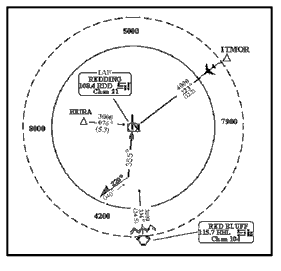
- Assigned an altitude to maintain until the aircraft is established on a segment of a published route or
instrument approach procedure. (See FIG 4-8-2.)
- EXAMPLE
- Aircraft 1 is cleared direct LEFTT. The MVA in the area is 3,000 feet, and the aircraft is at 4,000 feet. “Cross LEFTT at or above three thousand five hundred, cleared RNAV Runway One Eight Approach.” The MVA in the area is 3,000 feet and Aircraft 2 is at 3,000 feet. “Cleared direct LEFTT direct CENTR, maintain three thousand until CENTR, cleared straight-in RNAV Runway One Eight Approach.”
FIG 4-8-2 Approach Clearance Example 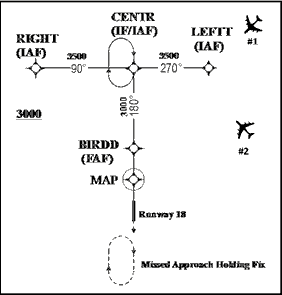
- NOTE:
- 1. The altitude assigned must assure IFR obstruction clearance from the point at which the approach clearance is issued until established on a segment of a published route or instrument approach procedure.
- 2. If the altitude assignment is VFR-on-top, it is conceivable that the pilot may elect to remain high until arrival over the final approach fix which may require the pilot to circle to descend so as to cross the final approach fix at an altitude that would permit landing.
- 3. An aircraft is not established on an approach until at or above an altitude published on that segment of the approach.
- REFERENCE
- FAA Order 8260.3 United States Standard for Terminal Instrument Procedures (TERPS), Para 11-3
- Established on a segment of a published route or instrument approach procedure, or (See FIG 4-8-1)
- Except for visual approaches, do not clear an aircraft direct to the FAF unless it is also an IAF, wherein the aircraft is expected to execute the depicted procedure turn or hold-in-lieu of procedure turn.
- Intercept angles greater than 90 degrees maybe used when a procedure turn, a hold-in-lieu of procedure turn pattern, or arrival holding is depicted and the pilot will execute the procedure.
- If a procedure turn, hold-in-lieu of procedure turn, or arrival holding pattern is depicted and the angle of
intercept is 90 degrees or less, the aircraft must be instructed to conduct a straight-in approach if ATC does not
want the pilot to execute a procedure turn or hold-in-lieu of procedure turn. (See FIG 4-8-3)
- PHRASEOLOGY
- CLEARED STRAIGHT-IN (type) APPROACH
- NOTE:
- 1. Restate “cleared straight-in” in the approach clearance even if the pilot was advised earlier to expect a straight-in approach.
- 2. Some approach charts have an arrival holding pattern depicted at the IAF using a “thin line” holding symbol. It is charted where holding is frequently required prior to starting the approach procedure so that detailed holding instructions are not required. The arrival holding pattern is not authorized unless assigned by ATC.
- EXAMPLE
- “Cleared direct SECND, maintain at or above three thousand until SECND, cleared straight-in ILS Runway One-Eight approach.”
- REFERENCE
- AIM, Paragraph 5-4-5, Instrument Approach Procedure Charts.
- AIM, Paragraph 5-4-9, Procedure Turn and Hold-in-lieu of Procedure Turn.
FIG 4-8-3 Approach Clearance Example For Aircraft On a Conventional Approach 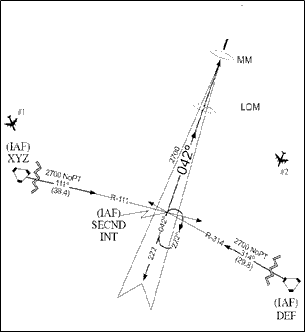
- EXAMPLE
- Aircraft 1 can be cleared direct to XYZ VORTAC, or SECND because the intercept angle is 90 degrees or less.
- Aircraft 2 cannot be cleared to XYZ VORTAC because the intercept angle is greater than 90 degrees.
- Aircraft 2 can be cleared to SECND if allowed to execute the hold-in-lieu of procedure turn pattern.
- Except when applying radar procedures, timed or visual approaches, clear an aircraft for an approach to an airport when the preceding aircraft has landed or canceled IFR flight plan.
- Where instrument approaches require radar monitoring and radar services are not available, do not use the
phraseology “cleared approach,” which allows the pilot his/her choice of instrument approaches.
RNAV APPLICATION
- For RNAV-equipped aircraft operating on unpublished routes, issue approach clearance for conventional or RNAV
SIAP including approaches with RF legs only after the aircraft is: (See FIG 4-8-4).
- Established on a heading or course direct to the IAF at an intercept angle not greater than 90 degrees and
is assigned an altitude in accordance with b2. Radar monitoring is required to the IAF for RNAV (RNP)
approaches when no hold-in-lieu of procedure turn is executed.
- EXAMPLE
- Aircraft 1 can be cleared direct to CENTR. The intercept angle at that IAF is 90 degrees or less. The minimum altitude for IFR operations (14 CFR, section 91.177) along the flight path to the IAF is 3,000 feet. If a hold in lieu of procedure turn pattern is depicted at an IAF and a TAA is not defined, the aircraft must be instructed to conduct a straight-in approach if ATC does not want the pilot to execute a hold-in-lieu procedure turn. “Cleared direct CENTR, maintain at or above three thousand until CENTR, cleared straight-in RNAV Runway One-Eight Approach.”
- Established on a heading or course direct to the IF at an angle not greater than 90 degrees, provided the
following conditions are met:
- (a) Assign an altitude in accordance with b2 that will permit a normal descent to the FAF.
NOTE: Controllers should expect aircraft to descend at approximately 150-300 feet per nautical mile when applying guidance in subparagraph h2(a).
- (b) Radar monitoring is provided to the IF.
- (c) The SIAP must identify the intermediate fix with the letters “IF.”
- (d) For procedures where an IAF is published, the pilot is advised to expect clearance to the IF at
least 5 miles from the fix.
- EXAMPLE
- “Expect direct CENTR for RNAV Runway One-Eight Approach.”
- (a) Assign an altitude in accordance with b2 that will permit a normal descent to the FAF.
- Established on a heading or course direct to a fix between the IF and FAF, at an intercept angle not greater
than 30 degrees, and assigned an altitude in accordance with b2.
- EXAMPLE
- Aircraft 1 is more than 5 miles from SHANN. The minimum altitude for IFR operations (14 CFR Section 91.177) along the flight path to SHANN is 3,000 feet. SHANN is a step down fix between the IF/IAF (CENTR) and the FAF. To clear Aircraft 1 to SHANN, ATC must ensure the intercept angle for the intermediate segment at SHANN is not greater than 30 degrees and must be cleared to an altitude that will allow a normal descent to the FAF. “Cleared direct SHANN, cross SHANN at or above three thousand, cleared RNAV Runway One-Eight Approach.”
FIG 4-8-4 Approach Clearance Example For RNAV Aircraft 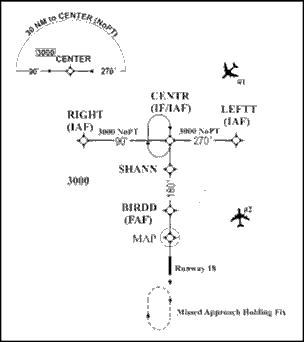
- EXAMPLE
- Aircraft 2 cannot be cleared direct to CENTR unless the aircraft is allowed to execute the hold-in-lieu of procedure turn. The intercept angle at that IF/IAF is greater than 90 degrees. The minimum altitude for IFR operations (14 CFR Section 91.177) along the flight path to the IAF is 3,000 feet. “Cleared direct CENTR, maintain at or above three thousand until CENTR, cleared RNAV Runway One-Eight approach.” The pilot is expected to proceed direct CENTR and execute the hold-in-lieu of procedure turn.
- Aircraft 2 can be cleared direct LEFTT. The intercept angle at that IAF is 90 degrees or less. The minimum altitude for IFR operations (14 CFR Section 91.177) along the flight path to the IAF is 3,000 feet. “Cleared direct LEFTT, maintain at or above three thousand until LEFTT, cleared RNAV Runway One-Eight Approach.” The pilot does not have to be cleared for a straight-in approach since no hold-in-lieu of procedure turn pattern is depicted at LEFTT.
- Established on a heading or course direct to the IAF at an intercept angle not greater than 90 degrees and
is assigned an altitude in accordance with b2. Radar monitoring is required to the IAF for RNAV (RNP)
approaches when no hold-in-lieu of procedure turn is executed.
- Clear RNAV-equipped aircraft conducting RNAV instrument approach procedures that contain radius to fix (RF)
legs:
- Via published transitions, or
- In accordance with paragraph h.
- Do not clear aircraft direct to any waypoint beginning or within an RF leg.
- Do not assign fix/waypoint crossing speeds in excess of charted speed restrictions.
- NOTE:
- 1. RNAV approaches (containing RF legs) that commence at 10,000 feet or above require special procedures that will be site specific and specified in a facility directive.
- 2. An RF leg is defined as a curved segment indicating a constant radius circular path about a defined turn center that begins at a waypoint. RF legs may have maximum airspeeds charted for procedural containment that must be followed.
- 3. If an aircraft is vectored off the procedure, expect the aircraft to request a return to an IAF.
FIG 4-8-5 Radius to Fix (RF) and Track to Fix (TF) 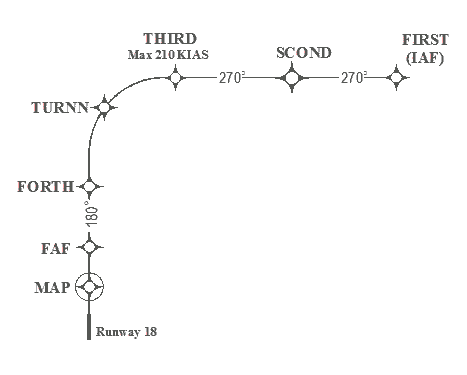
- NOTE:
- 1. The segment between THIRD and FORTH in FIG 4-8-5 is an RF leg.
- 2. The straight segments between waypoints in FIG 4-8-5 are TF legs.
- Where a terminal arrival area (TAA) has been established to support RNAV approaches, use the procedures under
subparagraph b above. (See FIG 4-8-6.)
- NOTE:
- 1. Aircraft that are within the lateral boundary of a TAA, and at or above the TAA minimum altitude, are established on the approach and may be issued an approach clearance without an altitude restriction.
- 2. The TAA minimum altitude may be higher than the MVA/MIA. If an aircraft is below the TAA minimum altitude, it must either be assigned an altitude to maintain until established on a segment of a published route or instrument approach procedure, or climbed to the TAA altitude.
- EXAMPLE
- Aircraft 1: The aircraft is at or above the minimum TAA altitude and within the lateral boundary of the TAA. “Cleared R NAV Runway One Eight Approach.”
- Aircraft 2: The MVA is 3000 feet and the aircraft is level at 4000 feet. The TAA minimum altitude is 4200 feet. The aircraft must be assigned an altitude to maintain until established on a segment of the approach. “Cross RIGHT at or above three thousand, cleared R NAV Runway One Eight Approach.”
- Aircraft 3: The aircraft is inbound to the CHARR IAF on an unpublished direct route at 7,000 feet. The minimum IFR altitude for IFR operations (14 CFR Section 91.177) along this flight path to the IAF is 5,000 feet. “Cleared direct CHARR, maintain at or above five thousand until entering the TAA, cleared RNAV Runway One Eight Approach.”
FIG 4-8-6 Basic “T” and TAA Design 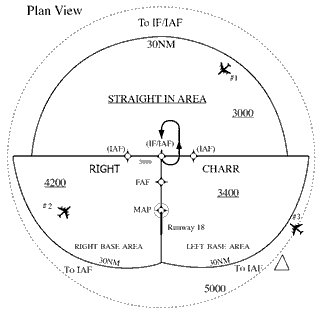
- When GPS TESTING NOTAMs are published and testing is actually occurring, inform pilots requesting or cleared for a RNAV approach that GPS may not be available and request intentions. Do not resume RNAV approach operations until certain that GPS interference is no longer a factor or such GPS testing exercise has ceased.
- During times when pilots report GPS anomalies, request the pilot's intentions and/or clear that aircraft for an alternative approach, if available and operational. Announce to other aircraft requesting an RNAV approach that GPS is reported unavailable and request intentions.
- When clearing an aircraft for an RNAV approach, and a GPS NOTAM is published (a WAAS NOTAM is not issued), both
GPS and WAAS may become unavailable. Therefore, when a GPS anomaly is reported, request the pilot's intentions.
NOTE: WAAS UNAVAILABLE NOTAMs are published to indicate a failure of a WAAS system component. Airborne GPS/WAAS equipment may revert to GPS-only operation which satisfies the requirements for basic RNAV (GPS) approaches to the airport of intended landing or filed alternate airport, if airborne equipment is approved for such operations.
4-8-2. CLEARANCE LIMIT
Issue approach or other clearances, as required, specifying the destination airport as the clearance limit if airport traffic control service is not provided even though this is a repetition of the initial clearance.
- PHRASEOLOGY
- CLEARED TO (destination) AIRPORT
4-8-3. RELAYED APPROACH CLEARANCE
TERMINAL
Include the weather report, when it is required and available, when an approach clearance is relayed through a communication station other than an air carrier company radio. You may do this by telling the station to issue current weather.
4-8-4. ALTITUDE ASSIGNMENT FOR MILITARY HIGH ALTITUDE INSTRUMENT APPROACHES
Altitudes above those shown on the high altitude instrument approach procedures chart may be specified when required for separation.
NOTE: To preclude the possibility of aircraft exceeding rate-of-descent or airspeed limitations, the maximum altitudes which may be assigned for any portion of the high altitude instrument approach procedure will be determined through coordination between the ATC facility concerned and the military authority which originated the high altitude instrument approach procedure.
4-8-5. SPECIFYING ALTITUDE
Specify in the approach clearance the altitude shown in the approach procedures when adherence to that altitude is required for separation. When vertical separation will be provided from other aircraft by pilot adherence to the prescribed maximum, minimum, or mandatory altitudes, the controller may omit specifying the altitude in the approach clearance.
NOTE: Use FAA or NGA instrument approach procedures charts appropriate for the aircraft executing the approach.
4-8-6. CIRCLING APPROACH
- Circling approach instructions may only be given for aircraft landing at airports with operational control towers.
- Include in the approach clearance instructions to circle to the runway in use if landing will be made on a runway other than that aligned with the direction of instrument approach. When the direction of the circling maneuver in relation to the airport/runway is required, state the direction (eight cardinal compass points) and specify a left or right base/downwind leg as appropriate.
- PHRASEOLOGY
- CIRCLE TO RUNWAY (number),
- or
- CIRCLE (direction using eight cardinal compass points) OF THE AIRPORT/RUNWAY FOR A LEFT/RIGHT BASE/DOWNWIND TO RUNWAY (number).
NOTE: Where standard instrument approach procedures (SIAPs) authorize circling approaches, they provide a basic minimum of 300 feet of obstacle clearance at the MDA within the circling area considered. The dimensions of these areas, expressed in distances from the runways, vary for the different approach categories of aircraft. In some cases a SIAP may otherwise restrict circling approach maneuvers.
- Do not issue clearances, such as “extend downwind leg,” which might cause an aircraft to exceed the circling approach area distance from the runways within which required circling approach obstacle clearance is assured.
4-8-7. SIDE-STEP MANEUVER
TERMINAL
Side-step Maneuver. When authorized by an instrument approach procedure, you may clear an aircraft for an approach to one runway and inform the aircraft that landing will be made on a parallel runway.
- EXAMPLE
- “Cleared I-L-S Runway seven left approach. Side-step to runway seven right.”
NOTE: Side-step maneuvers require higher weather minima/ MDA. These higher minima/MDA are published on the instrument approach charts.
4-8-8. COMMUNICATIONS RELEASE
interpretation 8If an IFR aircraft intends to land at an airport not served by a tower or FSS, approve a change to the advisory service frequency when you no longer require direct communications.
- PHRASEOLOGY
- CHANGE TO ADVISORY FREQUENCY APPROVED.
NOTE: An expeditious frequency change permits the aircraft to receive timely local airport traffic information in accordance with AC 90-66, Non-Towered Airport Flight Operations.
4-8-9. MISSED APPROACH
Except in the case of a VFR aircraft practicing an instrument approach, an approach clearance automatically authorizes the aircraft to execute the missed approach procedure depicted for the instrument approach being flown. An alternate missed approach procedure as published on the appropriate FAA Form 8260 or appropriate military form may be assigned when necessary. After an aircraft commences a missed approach, it may be vectored at or above the MVA/MIA, or follow the provisions of paragraph 5-6-3, Vectors Below Minimum Altitude.
- NOTE:
- 1. Alternate missed approach procedures are published on the appropriate FAA Form 8260 or appropriate military form and require a detailed clearance when they are issued to the pilot.
- 2. In the event of a missed approach involving a turn, unless otherwise cleared, the pilot will proceed to the missed approach point before starting that turn.
- 3. Pilots must advise ATC when intending to apply cold temperature compensation and of the amount of compensation required. Pilots will not apply altitude compensation, unless authorized, when assigned an altitude if provided an initial heading to fly or radar vectors in lieu of published missed approach procedures. Consideration should be given to vectoring aircraft at or above the requested compensating altitude if possible.
- REFERENCE
- FAA Order JO 7110.65, Para 4-8-11, Practice Approaches.
- FAA Order JO 7110.65, Para 5-6-3, Vectors Below Minimum Altitude.
- FAA Order JO 7110.65, Para 5-8-3, Successive or Simultaneous Departures.
- FAA Order 8260.19, Flight Procedures and Airspace, Para 8-6-6
- FAA Order 8260.3, United States Standard for Terminal Instrument Procedures (TERPS), Para 2-8-1 and Chapter 16.
- AIM, Paragraph 5-5-5, Missed Approach.
4-8-10. APPROACH INFORMATION
Specify the following in the approach clearance when the pilot says he/she is unfamiliar with the procedure:
- Initial approach altitude.
- Direction and distance from the holding fix within which procedure turn is to be completed.
- Altitude at which the procedure turn is to be made.
- Final approach course and altitude.
- Missed approach procedures if considered necessary.
- PHRASEOLOGY
- INITIAL APPROACH AT (altitude), PROCEDURE TURN AT (altitude), (number) MINUTES/MILES (direction), FINAL APPROACH ON (name of NAVAID) (specified) COURSE/RADIAL/AZIMUTH AT (altitude).
- Applicable notations on instrument approach charts which levy on the pilot the responsibility to comply with or act on an instruction; for example, “Straight-in minima not authorized at night,” “Procedure not authorized when glideslope/glidepath not used,” “Use of procedure limited to aircraft authorized to use airport,” “Procedure not authorized at night,” or a Snowflake icon indicating mandatory cold temperature compensation.
4-8-11. PRACTICE APPROACHES
interpretation 12Except for military aircraft operating at military airfields, ensure that neither VFR nor IFR practice approaches disrupt the flow of other arriving and departing IFR or VFR aircraft. Authorize, withdraw authorization, or refuse to authorize practice approaches as traffic conditions require. Normally, approaches in progress should not be terminated.
NOTE: The priority afforded other aircraft over practice instrument approaches is not intended to be so rigidly applied that it causes grossly inefficient application of services.
- Separation.
- IFR aircraft practicing instrument approaches must be afforded approved separation in accordance with Chapter 3, Chapter 4, Chapter 5, Chapter 6, and Chapter 7 minima until:
- (a) The aircraft lands, and the flight is terminated, or
- (b) The pilot cancels the flight plan.
- Where procedures require application of IFR separation to VFR aircraft practicing instrument approaches, IFR separation in accordance with Chapter 3, Chapter 4, Chapter 5, Chapter 6, and Chapter 7 must be provided. Controller responsibility for separation begins at the point where the approach clearance becomes effective. Except for super or heavy aircraft, 500 feet vertical separation may be applied between VFR aircraft and between a VFR and an IFR aircraft.
- REFERENCE
- FAA Order JO 7210.3, Para 6-4-4, Practice Instrument Approaches.
- FAA Order JO 7210.3, Para 10-4-5, Practice Instrument Approaches.
- Where separation services are not provided to VFR aircraft practicing instrument approaches, the controller must;
- (a) Instruct the pilot to maintain VFR.
- (b) Advise the pilot that separation services are not provided.
- PHRASEOLOGY
- “(Aircraft identification) MAINTAIN VFR, PRACTICE APPROACH APPROVED, NO SEPARATION SERVICES PROVIDED.”
- (c) Provide traffic information or advise the pilot to contact the appropriate facility.
- If an altitude is assigned, including at or above/below altitudes, the altitude specified must meet MVA, minimum safe altitude, or minimum IFR altitude criteria.
- All VFR aircraft must be instructed to maintain VFR on initial contact or as soon as possible thereafter.
NOTE: This advisory is intended to remind the pilot that even though ATC is providing IFR-type instructions, the pilot is responsible for compliance with the applicable parts of the CFR governing VFR flight.
- IFR aircraft practicing instrument approaches must be afforded approved separation in accordance with Chapter 3, Chapter 4, Chapter 5, Chapter 6, and Chapter 7 minima until:
- Missed Approaches.
- Unless alternate instructions have been issued, IFR aircraft are automatically authorized to execute the missed approach depicted for the instrument approach being flown.
- VFR aircraft are not automatically authorized to execute the missed approach procedure. This authorization must be specifically requested by the pilot and approved by the controller. When a missed approach has been approved and the practice approach is conducted in accordance with paragraph 4-8-11 a2, separation must be provided throughout the procedure including the missed approach. If the practice approach is conducted in accordance with paragraph 4-8-11 a3, separation services are not required during the missed approach.
4-8-12. LOW APPROACH AND TOUCH-AND-GO
Consider an aircraft cleared for a touch-and-go, low approach, or practice approach as an arriving aircraft until that aircraft touches down or crosses the landing threshold; thereafter, consider the aircraft as a departing aircraft. Before the aircraft begins its final descent, issue the appropriate departure instructions the pilot is to follow upon completion of the approach (in accordance with para 4-3-2, Departure Clearances). Climb-out instructions must include a specific heading or a route of flight and altitude, except when the aircraft will maintain VFR and contact the tower.
- EXAMPLE
- “After completing low approach, climb and maintain six thousand. Turn right, heading three six zero.”
- “Maintain VFR, contact tower.”
- (Issue other instructions as appropriate.)
NOTE: Climb-out instructions may be omitted after the first approach if instructions remain the same.